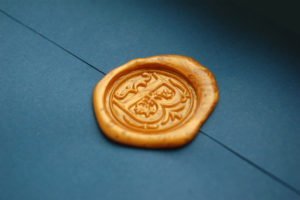In Him, you also, after listening to the message of truth, the gospel of your salvation – having also believed, you were sealed in Him with the Holy Spirit of promise….
– Ephesians 1:13
In his book The Holy Spirit, Billy Graham tells the story of an English missionary who died in India during the early 1900’s.
Immediately his former neighbors broke into his home and pillaged it, stealing the man’s possessions. The English Consul was notified, and the official went to the missionary’s home.
Since there was no knock on the door, the official simply pasted a piece of paper across it and affixed the seal of England on it. No one dared to break the seal because it represented the world’s most powerful nation. The power of England stood behind a piece of paper on the door. In the same way, when we are saved, the Holy Spirit takes up official residence within us, “sealing” us for Himself by His power and authority.
The Greek word for seal means “to confirm” or “to impress,” and it is used three times in the New Testament in connection with believers. This sealing represents two important concepts: security and ownership.
Sealing in the sense of security is illustrated in the sealing of Daniel in the lion’s den (Daniel 6:17), and in the irrevocable seal of the king in spoken of in Esther 3:12 and 8:8. The Greek word used in Matthew 27:65-66 to describe the Roman seal on Jesus’ tomb is the same word used in other New Testament Scriptures to speak of the seal of the Holy Spirit.
The seal was not to be broken except by order of the king.
This seal also signifies ownership. In Jeremiah 32:10 we read the prophet bought a piece of property, paid for it in front of witnesses, and sealed the purchase in accordance with the law and custom, making him the legal owner.
Ancient Ephesus was a port city, carrying on an extensive trade in lumber. A merchant looking for lumber would walk through the timber, select what he wanted, and stamp it with his own signet, or sign of ownership. When he was ready for the lumber, he would send an agent with the signet to locate all the timber carrying his seal. His agent would then claim and take all the lumber with the master’s mark on it back to the man who bought it.
In the East, a seal on a document was more important than the signature.
The signet used to imprint a seal usually sat in a ring and was inscribed with words or symbols. It often reflected an office of importance. It was commonly pressed into clay, because of its resulting permanence, although wax was used, too. Wax was not as desirable because it was prone to melt in the hot sun. Clay hardened over time, so that the clay itself would actually have to break in order to break the seal.
We are the clay. God is the master, and Jesus has bought us. The imprint of God impressed into our hearts seals us by the authority of the Lord on High. We are His, under His protection. The power of all heaven stands behind His mark.
He is sealed in us. He can’t leave without breaking the clay and His promise to never leave or forsake us. We are, quite literally, never alone as we walk through this world and await the Master’s call to reclaim His own.





















Leave a Reply